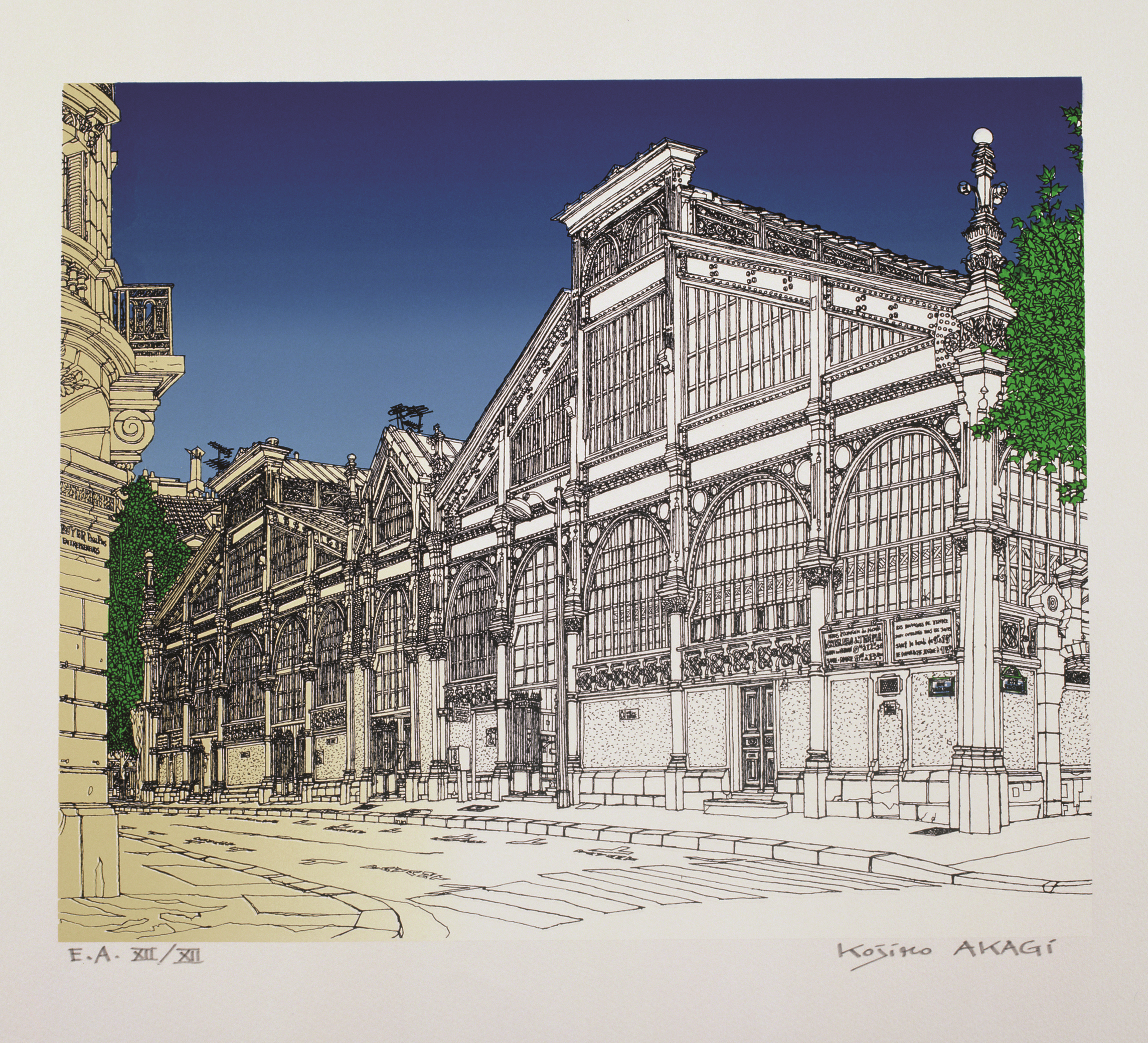Le Carreau du Temple / The Carreau du Temple / タンプル市場
Dublin Core
Title
Le Carreau du Temple / The Carreau du Temple / タンプル市場
Subject
Sérigraphie, Temple
Description
C’est au milieu du 19e siècle que se développent en Angleterre les techniques de construction de bâtiments avec des structures en métal et en verre. Puis elles se répandent en France. Cette illustration montre un marché permanent construit en 1863. A Châtelet-Les Halles, se trouvait l’ancien marché central de Paris, fait de plusieurs bâtiments construits selon cette même technique. Ce lieu, surnommé «le ventre de Paris», a été détruit et le marché a déménagé à Rungis. Le quartier des Halles est devenu ce que l’on en connait aujourd’hui. L’appellation Halles Baltard, qui reprend le nom de son architecte, est très courante pour désigner ce style de construction de halles. Le quartier du Temple regroupait de nombreux fabricants de vêtements en cuir et de prêt-à-porter pour homme. Sur le marché du Carreau du Temple, il y avait davantage de boutiques de vêtements à bas prix que de marchands de produits alimentaires. Les clients venaient essentiellement des classes populaires. Bien avant cette époque, il y avait dans ce quartier le Château des Chevaliers du Temple. Leur influence s’étendait sur toute la Méditerranée jusqu’à Jérusalem. Ils possédaient une grande fortune, grâce à leur activité de banquier et d’échanges de devises. Le roi Philipe IV, jaloux de leur pouvoir, s’était lié au pape de Rome afin de monter un faux crime. En 1314, après avoir confisqué la fortune des Templiers, ils exécutèrent tous leurs membres. Lors de la Révolution française, c’est ici, dans ce château vidé, que Louis XVI et la famille royale sont ramenés de Versailles. Ce château n’existe plus aujourd’hui, mais il en reste quelques traces éparses.
Since the middle of the 19th century construction of buildings using steel and glass was developed in Britain. It also spread to France and this permanent market was built in 1863. Châtelet-Les Halles today is the reminiscent of the past central wholesale market and many buildings sharing the same format as this one stood, known as the stomach of Paris. They were demolished and transferred to Rungis in the suburbs and it ended up being a park now. In France the architect Baltard was designing such buildings so his name is more widely used to indicate this style of market. Because there are many men’s ready-to-wear and leather clothing makers in the area around Temple, in this market there were more stall keepers who would hang out clothes to sell directly and cheaply rather than food and people in the lower classes would gather.Much earlier than this the Château des Chevaliers du Temple was around here whose power extended all over the Mediterranean as far as Jerusalem, very rich with banking and currency exchanging businesses. Philippe IV became jealous of them and conspired with the Pope to devise a scheme to confiscate the property of this monastic order and its members were executed. It was in the vacant castle that Louis XVI, Marie Antoinette and the royal family were confined and forced to live out their days. The castle has been destroyed now but it used to be around here.
十九世紀の半ばから、鉄骨とガラスで、建物を作る工法が、イギリスから発達した。フランスにも広まって、一八六三年に建てられた常設市場である。現在のシャトレ・レアルは、昔のパリ中央卸市場跡で、ここと同じ形式の建物が何棟も建ち並び、パリの胃袋と呼ばれていたが、取り壊されて、郊外のランジスに移転し、現在の公園のようになってしまった。フランスでは、バルタールという建築家が建物を設計していたので、「バルタール」の方が、市場のこの建物様式を指す言葉として通用する。タンプル一帯は、男子既製服や、皮衣料メーカーが多い地区なので、ここの市場では、庶民の食品よりも、そんな露天商が衣類を沢山吊るして直売安売りされていて、下層階級の客が集まっていた。 もっと大昔は、この辺りにタンプル騎士修道会の城があって、エルサレムまで、地中海一帯に力を持ち、銀行、両替業務で大金持ちだった。嫉妬して狙った王様フィリップ四世が、ローマ法王と組んで、でっち上げの罪で、一三一四年この修道会の財産を没収、団員は処刑されてしまう。その後の空いていた城に、フランス革命の時にベルサイユから連れてこられたルイ十六世やマリー・アントワネット、王様一家を閉じ込めて住まわせたのだった。そのお城も取り壊されて今は無いが、その建っていた跡がこの辺りになる。
Creator
Kojiro Akagi (1934-2021)
Date
Août 1985 / August 1985
Rights
Fonds de dotation Kojiro AKAGI
Format
Sérigraphie, Atelier Del Arco, 50 tirages + 12 E.A. romain, sur papier Arches 49,5 x 65 cm.
Type
Sérigraphie
Tags
Citation
Kojiro Akagi (1934-2021)
, “Le Carreau du Temple / The Carreau du Temple / タンプル市場,” Kojiro Akagi - Fonds de dotation Kojiro AKAGI , accessed December 27, 2025, https://kojiroakagi.com/gallery/items/show/70.

